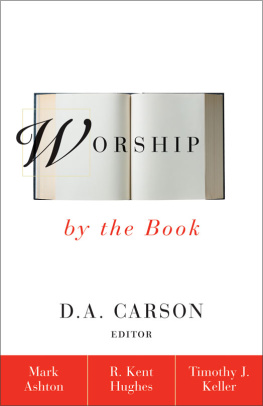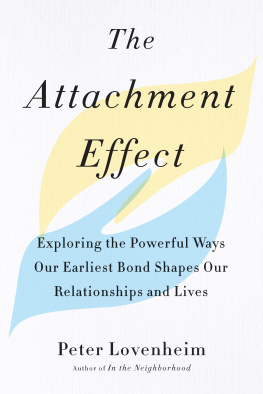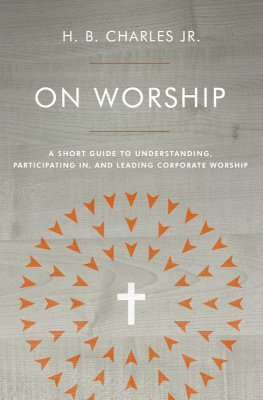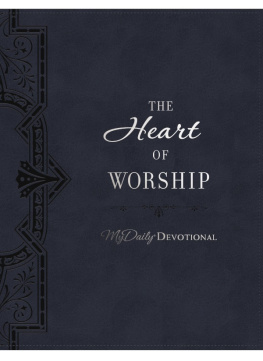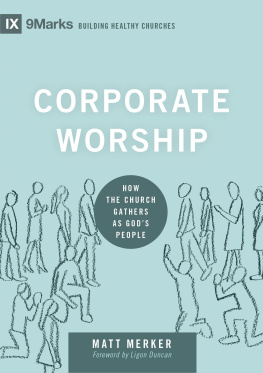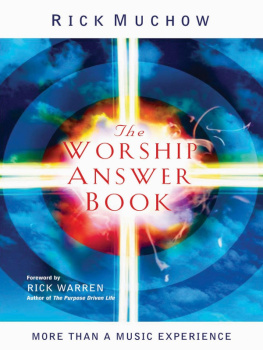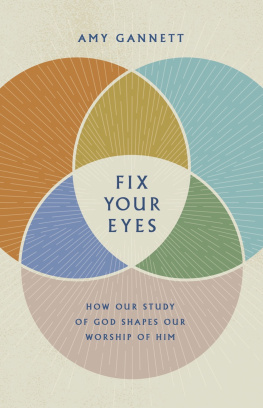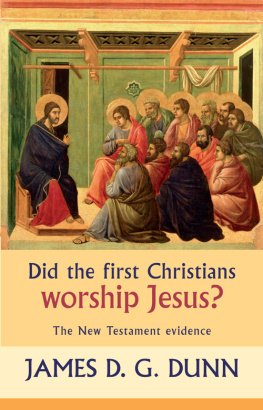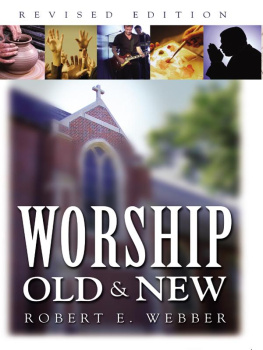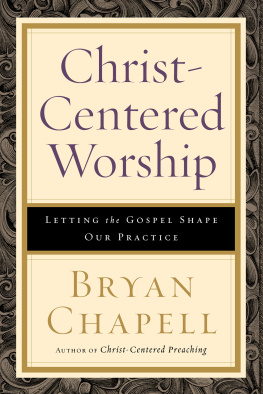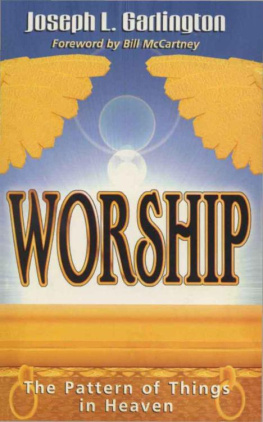ZONDERVAN
Worship by the Book
Copyright 2002 by D. A. Carson, Timothy Keller, Mark Ashton, and Kent Hughes
All rights reserved under International and Pan-American Copyright Conventions. By payment of the required fees, you have been granted the non-exclusive, non-transferable right to access and read the text of this e-book on-screen. No part of this text may be reproduced, transmitted, downloaded, decompiled, reverse engineered, or stored in or introduced into any information storage and retrieval system, in any form or by any means, whether electronic or mechanical, now known or hereinafter invented, without the express written permission of Zondervan.
ePub Edition April 2010 ISBN: 978-0-310-87429-4
Requests for information should be addressed to:
Zondervan, Grand Rapids, Michigan 49530
Library of Congress Cataloging-in-Publication Data
Worship by the book/D. A. Carson, editor; with Mark Ashton, R. Kent Huges, and Timothy J. Keller.
p. cm.
Includes bibliographical references and index.
ISBN 0-310-21625-7
1. Public worship. 2. Worship programs. I. Carson, D. A.
BV15.W66 2002
264-dc21
2002000789
Acknowledgments and permission statements for copyrighted materials used in this book are provided on page 9, which hereby becomes part of this copyright page.
All Scripture quotations, unless otherwise indicated, are taken from the Holy Bible: New International Version. NIV. Copyright 1973, 1978, 1984 by International Bible Society. Used by permission of Zondervan. All rights reserved.
05 06 07 08
T here are so many books on the subject of worship these days that I had better make clear right away what we are trying to accomplish in this volume.
This is not a comprehensive theology of worship. Still less is it a sociological analysis of current trends or a ministers manual chock full of how to instructions. We have not attempted detailed historical analyses of our respective traditions, nor have we devoted much space to interaction with other discussions. Rather, after a preliminary chapter on the biblical theology of worship, the remaining three chapters move from theological reflection to practical implementation of patterns of corporate worship in the local churches we represent. Complete service outlines are included, for many ministers will find the arguments more helpful and fruitful if they are fleshed out in detailed outlines.
Three of us are currently pastorsan Anglican, a Baptist, and a Presbyterian. The fourth teaches at a seminary but has served as pastor in earlier years. What unites us is our strong commitment to the ministry of the Word; our respect for historical rootedness; and our deep commitment, nevertheless, to contemporaneity and solid engagement with unconverted, unchurched people. We are as suspicious of mere traditionalism as we are of cutesy relevance. What we provide is the theological reasoning that shapes our judgments in matters of corporate worship, along with examples that have emerged from our ministries. In each case we have tried to interact with our respective traditions without being padlocked to them.
For reasons of brevity and clarity, we have included relatively few footnotes and interacted with a minimum of the voluminous secondary literature. It will not take long for readers to discover where we disagree with one another. Sometimes the disagreement is over something tied to our respective denominational distinctives; sometimes disagreements reflect the different subcultures in which we serve; sometimes they are mere judgment calls. Nevertheless, the degree of agreement is impressivepartly, I think, because each of us takes biblical theology seriously.
We would be the first to acknowledge that on countless points brothers and sisters in Christ in other cultures may want to tweak what we say to better fit their own worlds. For example, Korean patterns of public prayer are rather different from most of what is found in the West, and musical styles in the rising indigenous churches of sub-Saharan black Africa would generate a somewhat different discussion of some points. But we are addressing the worlds we know best from the Word we love best. Our prayer is that this record of our own struggles, reflections, and practices may stimulate others to careful, biblically informed reformation of corporate worship.
I want to record my thanks to Dr. Don Hedges, who efficiently tracked down the copyright holders of the pieces cited on the service sheets, and to my graduate assistant, Sigurd Grindheim, who ably compiled the indexes.
Soli Deo gloria.
D. A. CARSON
Chapter 1
WORSHIP UNDER THE WORD
D. A. CARSON
The Challenge
T o construct a theology of worship turns out to be a difficult task. In addition to the ordinary difficulties associated with constructing an informed, balanced, and reasonably comprehensive theology of almost any biblical theme, the preparation of a theology of worship offers special challenges.
1. At the empirical level, the sad fact of contemporary church life is that there are few subjects calculated to kindle more heated debate than the subject of worship. Some of these debates have less to do with an intelligible theology of worship than with mere preferences for certain styles of music (older hymns versus contemporary praise choruses) and kinds of instruments (organs and pianos versus guitars and drums). Other flash points concern the place of special music (the North American expression for performance music), congregational singing, liturgical responses, clapping, drama. All sides claim to be God-centered. The moderns think the traditionalists defend comfortable and rationalistic truths they no longer feel, while the stalwarts from the past fret that their younger contemporaries are so enamoured of hyped experience they care not a whit for truth, let alone beauty. Sometimes one senses that for many there are only two alternatives: dull (or should we say stately?) traditionalism, or faddish (or should we say lively?) contemporaneity. We are asked to choose between as it was in the beginning, is now, and ever more shall be, world without end, and old is cold, new is true. The one side thinks of worship as something we experience, often set over against the sermon (first we have worship, and then we have the sermon, as if the two are disjunctive categories); while the other side thinks of worship as ordered stateliness, often set over against all the rest of life.
In fact, the issues are more complicated than this simplistic polarization suggests. One must reckon with the propensity of not a few contemporary churches to reshape the corporate meetings of the church to make them more acceptable to every sociologically distinguishable cultural subgroup that comes alongboomers, busters, Gen Xers, white singles from Cleveland, or whatever. Although one wants to applaud the drive that is willing, for the sake of the gospel, to remove all offenses except the offense of the cross, sooner or later one is troubled by the sheer lack of stability, of a sense of heritage and substance passed on to another generation, of patterns of corporate worship shared with Christians who have gone before, or of any shared vision of what corporate worship should look like. This in turn generates a swarm of traditionalists who like things that are old regardless of whether or not they are well founded. They cringe at both inclusive litanies and guitars and start looking for an alternative to alternative worship.
Moreover, to gain perspective on the possible options, one must reflect on some of the historical studies that examine the worship practices of some bygone era, sometimes explicitly with the intention of enabling contemporaries to recover their roots or rediscover past Intriguingly, many of the new nontraditional services have already become, in some churches, entrenched traditionsand, on a historical scale, arguably inferior ones.

